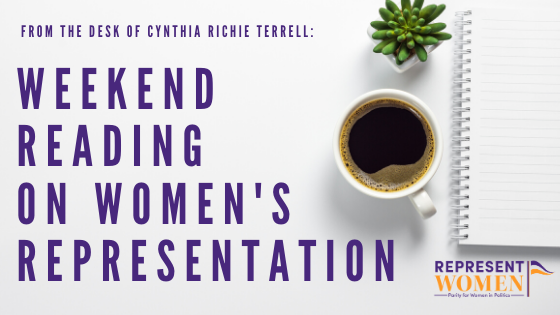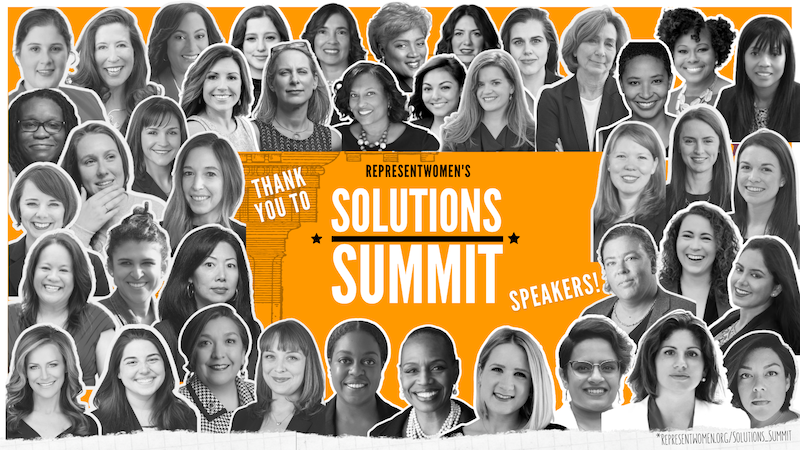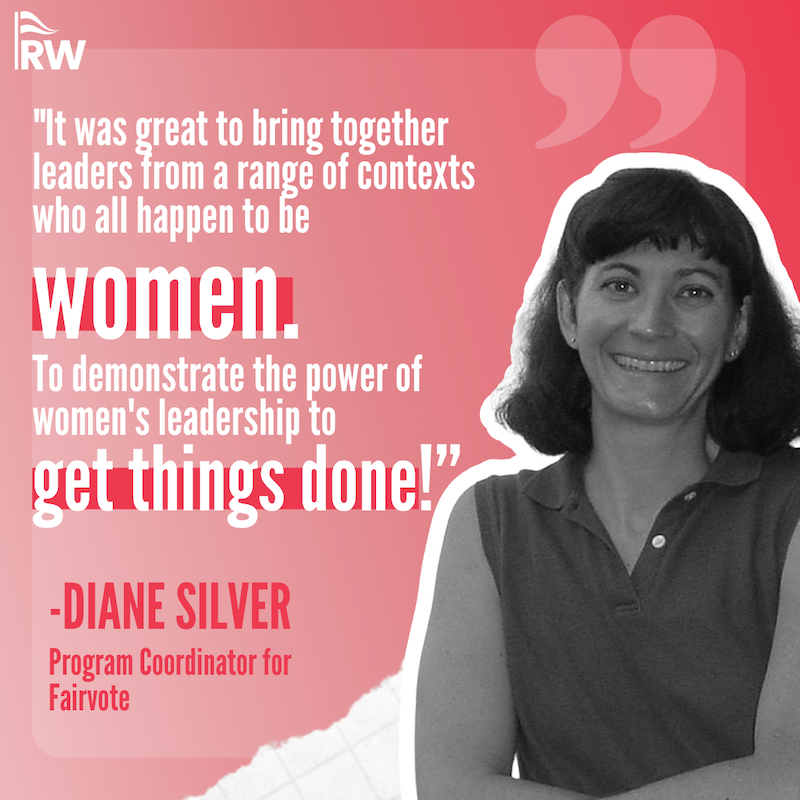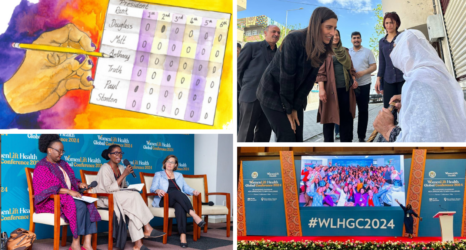
Weekend Reading on Women’s Representation is a compilation of stories about women’s representation in politics, on boards, in sports and entertainment, in judicial offices and in the private sector in the U.S. and around the world—with a little gardening and goodwill mixed in for refreshment!
Women Generate Solutions to Defend and Strengthen U.S. Democracy

In March of 2022 RepresentWomen hosted a Democracy Solutions Summit featuring women experts speaking on a wide range of challenges facing our nation including election administration, campaign finance, voting rights, the Electoral College, antiquated voting rules, and fair representation.
The purpose of the Summit was to elevate women’s voices in the democracy reform ecosystem, build community across issue silos, and provide advocates with specific recommendations about how to get involved.
This week the team at RepresentWomen released a comprehensive Take Action Resource Guide that includes links for how all of us can get involved and help to build a 21st century democracy:
The Solutions Summit culminated in the creation of a resource guide of take-action items that were identified throughout the course of the Summit. The guide includes suggestions of practical ways to help combat systemic representation inequalities in politics, links to sign up for volunteering and advocacy efforts, and a variety of further readings and resources to take the next step in learning about the various issues discussed at the summit. Additionally, it highlights the female changemakers who spoke about each issue at the summit and provides links to further background about each speaker.
The resource guide embodies RepresentWomen’s mission of taking action to advance solutions that build women’s political power and create a 21st-century democracy. It was created to provide convenient access to tangible, effective steps that anyone can take to learn about the systemic barriers barring women from full and meaningful participation in US politics, and it is all you need to jump in and be a part of the solution.
There was such an enthusiastic response to the summit that we plan to hold the gathering annually and hope to engage an even wider audience in the years to come. Summit speakers Amber McReynolds, Danielle Allen, Ava Mateo, Rebecca Chavez-Houck, Yael Bromberg and Diane Silver shared their take on the summit:
Women Secretaries of State on Frontlines of Election Administration Battles
Local election administrators—85 percent of whom are women—and women secretaries of state are facing threats and violence according to this piece by Barbara Rodriguez for The 19th:
It’s been two years since secretaries of state were propelled into the public consciousness for running America’s elections — and pushing back against lies about the 2020 election’s legitimacy that ultimately led to an insurrection at the U.S. Capitol. As falsehoods about that election and their deadly consequences go on display during hearings by a special congressional committee on the Jan. 6, 2021, attack, the ongoing realities of challenging those lies continue for these secretaries.
These election officials back in 2020 debunked lies, myths and conspiracy theories about a presidential election that ultimately was deemed the most secure in U.S. history. Secretaries of state of both parties were subject to harassment for addressing disinformation (misleading information that is intentionally designed to cause harm to people) and misinformation (misleading information that is shared because a person truly believes it).
But for the women secretaries of state serving in key battleground states — many of whom are Democrats — the work of combating inaccurate information made them targets for misogynistic harassment and threats of violence. In the lead-up to the nation’s next major election this year, some of these women secretaries say the harassment has not let up as they devote even more time to combating misinformation.
Sarah Palin Among Four Candidates To Compete in Ranked-Choice Voting General Election
Voters in Alaska adopted a top four open primary, followed by a ranked-choice voting general election in 2020—and Sarah Palin has finished in the preliminary top four contest, according to this article in The Washington Post:
Voting in Alaska’s special primary election to replace the late Rep. Don Young (R) closed Saturday as four dozen candidates — including former vice-presidential candidate Sarah Palin — faced off under unusual new rules.
Early results show Palin about 10 percentage points ahead of Republican challenger Nick Begich III, a sizable lead in the hotly contested race. However, the outcome could still change significantly as only 54 percent of votes have been counted, and the Associated Press has yet to call any winners. Alaska is not expected to release any more vote totals until Wednesday.
The top four finishers, regardless of party affiliation, will advance from the primary and face off on Aug. 16. The winner of that ranked-choice election will serve out the remainder of Young’s term.
Nathanial Rakich writes about the potential impact of the ranked ballot in Alaska in this piece on FiveThirtyEight:
There are also several candidates with more traditional resumes and points in their favor. Republican John Coghill, for instance, still has 52 percent name recognition (as measured by the share of likely voters who can form an opinion of him) from his days as state Senate majority leader. Meanwhile, Republican state Sen. Josh Revak, who used to work for Young, has been endorsed by his widow. And Anchorage Assemblyman Christopher Constant, former state Rep. Mary Peltola (who would also be the first Alaska Native in Congress) and state Rep. Adam Wool all have the advantage of being actual Democrats; if they don’t go for Gross, Alaska’s Democratic voters have to vote for someone. The problem with all these candidates, though, is that they have all raised very little money, and none of them registered above 5 percent in the poll.
In all honesty, though, it may not matter much who snags the fourth slot. When it comes to the general election, the candidate with the fewest first-place votes will be eliminated and their support redistributed to the candidates their voters ranked second. So unless the complexion of the race changes drastically during the next two months, the fourth-place finisher on Saturday will probably be the first to be eliminated in August. After all, that’s what the Alaska Survey Research poll found, no matter whether Sweeney, Constant, Peltola or Claus was the fourth contender.
Moreover, in each scenario, it was Begich who emerged victorious after all the ranked-choice voting rounds were complete. This is certainly not guaranteed to be the case after two months’ of campaigning, but as a starting point, it makes sense: Among the three front-runners, Begich is the ideologically middle choice. If Palin is eliminated second, most of her support is likely to go to fellow Republican Begich, not Gross. And if Gross is eliminated second, most of his support is likely to go to Begich, not Palin.
Again, the outcome of this special election is still far from certain, but it at least looks possible that this is one election where ranked-choice voting could make a material difference. Based on her high profile, Palin may well finish the primary in first place. Under the old system (and the one that most other states use), this would have made her the Republican nominee, and in a red state like Alaska, she likely would have won the general election against whoever Democrats nominated — despite her unpopularity. But the Alaska system prevents her from winning with just a plurality of the vote and ensures that the winner is someone who can (eventually) earn majority support. That probably won’t be Palin.
Wins for Women in Australian Parliament and Cabinet
#Australia 🇦🇺 has a changed political make-up after recent parliamentary #elections, with more #womenMPs and more diversity.
— IPUparliament (@IPUparliament) June 9, 2022
The House of Reps will no doubt rise in the #IPU ranking of women in #parliament compared with the 2019 parliament which at 57th.
➡️https://t.co/HdebObgvMA pic.twitter.com/FpQ9d4ke9I
Women will hold nearly 40 percent of seats in the Australian lower house, due to the confluence of great candidates and a ranked-choice ballot that translated votes into seats. Sam Mostyn, president of Chief Executive Women, writes about the gains for women in Australia in the Financial Review:
Last month we witnessed record numbers of women sworn into the highest decision-making table in our land. At Chief Executive Women our mission is to enable women leaders, so we warmly welcome this historic moment – a gender-balanced federal cabinet marks an important moment for women’s leadership in Australia.
Many have reflected on the impact of the women’s vote in this election – and yes, women have spoken. Regardless of politics, we should take this moment to celebrate the election of strong, diverse women into our parliament to represent communities around the country.
For the first time in the Australian parliament, women represent almost 40 per cent of the House of Representatives, and at least half of the Senate, with more representatives from First Nations and diverse linguistic and cultural backgrounds than ever before. It is also pleasing to see the strong representation of women in the shadow cabinet.
CEW has long advocated for higher women’s representation at decision-making tables across the country. This year, we issued an election policy platform for the first time. We called for a gender-balanced cabinet as one of our five priority asks.
While the wins for women in Australia are encouraging, additional measures such as legislative quotas must also be considered writesMicheal Swinsburg in Investment Magazine:
In Australia, we have just elected an historic gender and ethnically diverse Federal parliament with women’s representation in the lower house at 38% and over 50% in the Senate. Meanwhile, Sam Mostyn, of Chief Executive Women (CEW), laments “progress towards balanced leadership in decision making roles has stalled at unacceptably low levels (over the last five years)”. Overseas, last year the French parliament legislated a 40% gender quota for corporate leadership having dealt with political quotas in 2000.
Focusing on the issues targets or quotas are meant to address including the failings of merit, unconscious bias, and slow cultural change, we look at global research and back to our 2019 paper – The Long Game – Building a diverse talent pipeline.
Global data supports legislated quotas in bringing more qualified women into politics and corporate boards without the much-opined disasters. However, we see little gender trickle down into executive ranks. Unsurprisingly, quotas are only part of a comprehensive plan to drive culture change towards a pipeline of diverse and inclusive future leaders. Whilst quotas maybe a blunt tool often tainted by negative sentiment, to ignore them leaves us open to criticism that we aren’t doing enough, fast enough. The choice is ours.
Renewed Push for Gender Parity in Kenya

According to the Inter-Parliamentary Union, women hold 21.4 percent of seats in parliament in Kenya that uses the same first-past-the-post or winner-takes-all voting system used for most elections in the United States. There is a growing demand in Kenya to elect more women to office as this story on KBC reports:
Women’s equal participation and leadership in political and public life are essential to achieving the Sustainable Development Goals for any county or country.
However, according to statistics, women are under-represented at all levels of decision-making worldwide, thus making achieving gender parity in political life a dead dream.
There is growing recognition of the untapped capacity and talents of women and women’s leadership…..
Women’s participation in politics helps advance gender equality and affects both the range of policy issues that get considered and the types of solutions that are proposed.
Gender Is a ‘Social Construct’

Hilary Pennington, executive vice president of programs at the Ford Foundation, explores the growing understanding of gender in this thoughtful piece that should help to frame our collective work for gender balance in politics:
In Mexico’s southern state of Oaxaca, muxes, a part of the Indigenous group, the Zapotecs, play an important role in families and communities. A muxe is a person who is assigned male at birth yet adopts roles traditionally associated with women. They cook, care for children and elderly relatives, and sew the community’s ornate embroidered wares.
In the Philippines, the bakla, who transcend the duality between men and women, have been historically renowned as leaders. “More man than man, more woman than woman,” the bakla are seen as a third gender and regarded as one of the most visible and celebrated LGBTQ+ cultures in Asia.
In the United States, Native Americans have long embraced two-spirit people, who identify as having both feminine and masculine spirits. In fact, more than 150 different Native American tribes acknowledge third genders in their communities.
Ms.’s 50th Birthday!
It’s 50 years since feminist campaigner Gloria Steinem co-founded the first magazine in America to be owned, run, and written by women. (Hey, that’s us!) #MsReads via @BBCNewshttps://t.co/NNz0lqEvMs
— Ms. Magazine (@MsMagazine) June 16, 2022
Many happy returns of the day to Ms. magazine that turns 50 at the end of this year. (P.S. A subscription to Ms would make a perfect Father’s Day gift!)
I am so grateful to Ms. for nurturing the flame of feminism and providing a platform for the ongoing conversations about the policies and perspectives necessary for women’s equality.
Hear more about the history of Ms. from the BBC and read more about the Ms. founders and contributors in The New York Times:
Ms. magazine’s first stand-alone issue came out 50 years ago, in the summer of 1972 — a publication for women whose interests went “beyond the limits of home and husband.” It was the first mainstream magazine by and for women, and it counted Alice Walker, Adrienne Rich, Toni Morrison and Vivian Gornick among its early writers. Kathleen Hanna, the Bikini Kill frontwoman, used cutouts from her mother’s copies for early feminist art projects. Judy Blume, the children’s author, has said it helped her feel less alone. Some women hid it from their husbands; for others, it was a catalyst to leave them.
Advertisers scoffed at the idea of paying money to appear in its pages. The magazine was banned from some libraries, and some distributors refused to sell it on newsstands. At least one prominent male journalist snarked that the women would “run out of things to say.” Even President Richard Nixon thought it was preposterous — wondering, in a conversation with Henry Kissinger, how many people “give one shit” about Gloria Steinem’s feminist magazine.
The answer turned out to be millions. The magazine’s preview issue sold out in eight days and yielded at least 20,000 letters in response.
Ms. has faced its share of controversies over the years. The magazine was criticized as too radical but also not radical enough. There were jealousies and disagreements. Was Ms. doing enough for lesbians? For women of color? For rural women? Alice Walker — who would express her own controversial positions later in her life, including some considered to be antisemitic — resigned in 1986, dismayed by how white the magazine’s covers had become. (She would later return as a contributor.)
But for all its controversies — or perhaps because of them — those young issues of Ms. have never felt more prescient. Last month, The Times convened a handful of early Ms. editors and writers to reflect on the magazine’s founding and where the feminist movement is today. This conversation has been edited for length and clarity.
Feminist Must-Reads
Check out the great book recommendations from the team at RepresentWomen:

Nasturtiums, lavender, and larkspur are blooming in my garden this week.
I am excited for the busy summer ahead filled with primaries, conferences, and endless opportunities to engage with lots of interesting people about the imperative for gender balance in politics, in the United States, in our lifetimes—and the systems strategies to help us reach that goal.
Cynthia
Up next:











